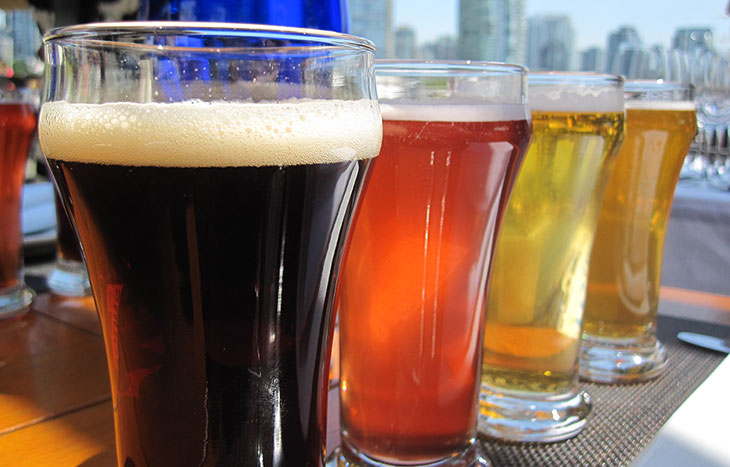History, Chemistry, and Cold Beer

Dark amber or brown glass greatly reduces UV light from spoiling the beer.
(ISNS) -- When next you reach for a cold one in the buzzing heat of a summer day, you will probably give no thought to the glorious history, complicated chemistry, and abundant myths associated with what you are drinking.
That's OK. Just know you are participating on one of humanities oldest and most popular activities. After water and tea, beer is the third most favored drink in the world. It is one of the first by-products of human agriculture. Beer may, in fact, be a reason for civilization.
The United States is a splendid place to drink beer, said British-born expert Charles Bamforth of the University of California, Davis. The market is huge and diverse, with an enormous variety of the stuff available from breweries large and small. Beer is made of fermented cereal grains. Usually, the grain is barley, but wheat beer is common, sometimes rye, rice, corn, or even sorghum.
The drink was discovered about 8,000 years ago, historians believe, likely the result of accidents in bakeries.
"The story goes that in what is now Iraq they used to eat barley," said Bamforth. "Someone got some wet, and it started to sprout. It got softer and easier to digest and chew, and it tasted better."
They made bread out of it and liked it.
"That bread was somehow crumbled in jars and mixed with water. Wild yeast came along and converted it to a delicious drink and when they drank it, they fell over. They were kind of happy about that," Bamforth said.
That still required someone to look at the mess in the jar and think, "hey, what if I drank some?" The brave soul, like the first person to eat an oyster, is lost to history.
Historians think the discovery made people happy enough to consider ending life as hunter gatherers and settling down to agriculture and brewing, the beginnings of civilization. Beer even became a leading source of nutrition and was tied up with religious observances and feasts. Egyptian Pharaohs drank it. Sophocles urged Greeks to enjoy beer responsibly in the fifth century B.C.
The beer of ancient Mesopotamia and modern beer taste and look nothing alike. Ancient beer was unfiltered and included various herbs and spices, uncommon today. By around the ninth century, brewers -- mostly European monks -- began adding hops in their beers, Bamforth said.
Hops, a flower, adds bitterness to the taste, a complexity to the aroma and acts as a preservative. It is the taste and smell we now most associate with beer.
That accidental brewing now is duplicated in modern breweries.
The process begins with malted grain. Malting means the grain is soaked in water so it begins to germinate but then is heated before the process is completed. The malting produces enzymes that convert starch in the grain to sugar. Yeast then turns most of the sugar into alcohol.
Beers come with several urban legends.
One common misconception is that European beers have a higher alcohol content than American beers. Not so, says Bamforth.
"The reality is the beers tend to be stronger in America. If you compare Guinness, they have less alcohol in it than Budweiser. In the U.K., beer tends to be lower in alcohol because it is taxed according to its strength," Bamforth said.
American beers usually contain 4-6 percent alcohol.
The difference is that Americans generally like a milder beer and European beer has a more intense flavor, but it has nothing to do with alcohol content. In the last 30 years, small craft brewers have sprung up making a more European-style beer that is now the fastest growing segment of the business.
Another myth is that beer in a bottle is better than beer in a can and that also is not true, Bamforth said.
The enemies of beer are light and air, he said. No matter how tight the bottle, air and light eventually get in and the longer the beer is in the bottle the more likely it is to get a "skunky" taste, the result of light altering the chemistry of the hops. That's why Heineken in New York is not the same as Heineken in Amsterdam. It has travelled across an ocean, which takes time.
Cans do not let in air or light.
Brown bottles are better than green bottles, which are better than clear bottles, because they let in less light. Brewers who sell beer in clear bottles, like the makers of Mexico's Corona, use chemically modified hops to counter the effects of light, Bamforth said.
Huge breweries, like Anheuser-Busch, produce gigantic quantities around the world, all exactly the same, a feat of industrial chemistry almost unmatched in the world.
But, the process fascinates many and there is a booming business in supplying home brewers who run mini-Coors in their basements, either because they love beer or are fascinated by the chemistry.
Rabbi Charles Arian of Norwalk, Conn., brews beer at home, just a couple of gallons at a time from kits. His equipment costs about $120.
He does it because of the process.
"I'm an urban person," Arian said. "As a non-scientist and liberal arts guy, it's the interaction of nature and learning how something works. It really works. If you put the right combination of stuff together and the temperature is right, you get predictable results."
It doesn't matter to Bamforth what you drink.
"I don't think anyone has the right to decree what is a good and bad beer," Bamforth said.
Just enjoy.

